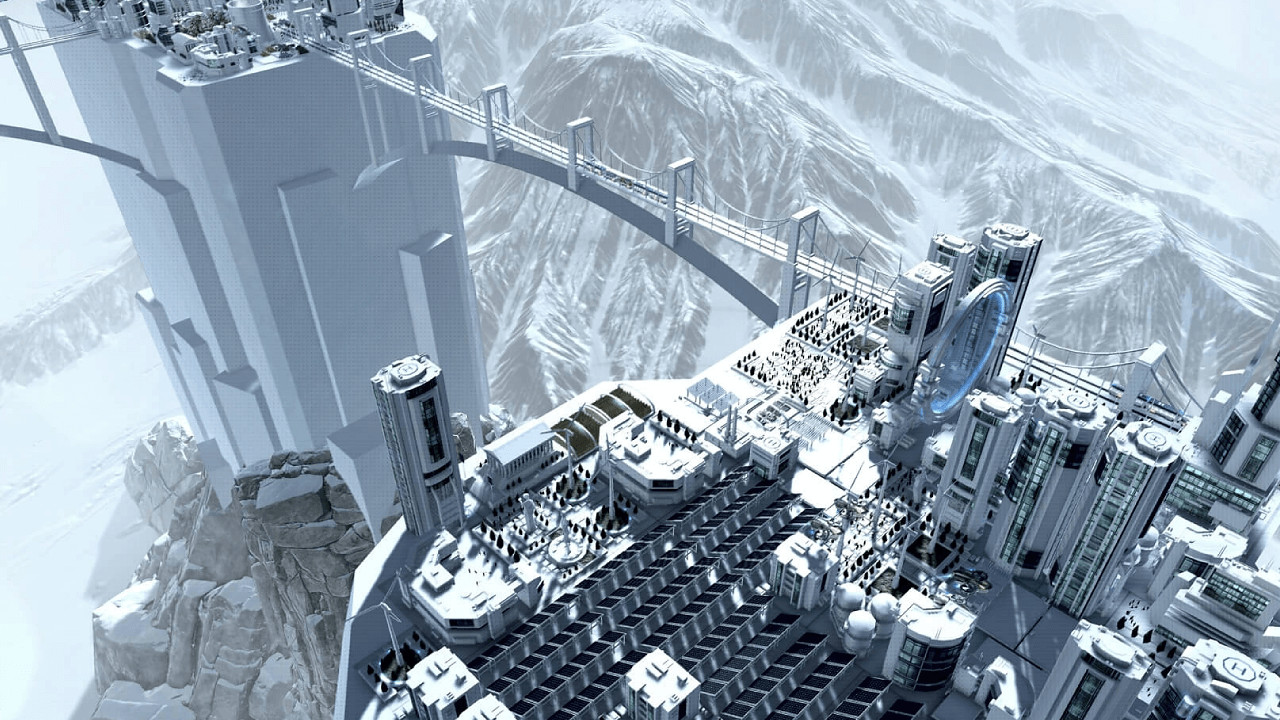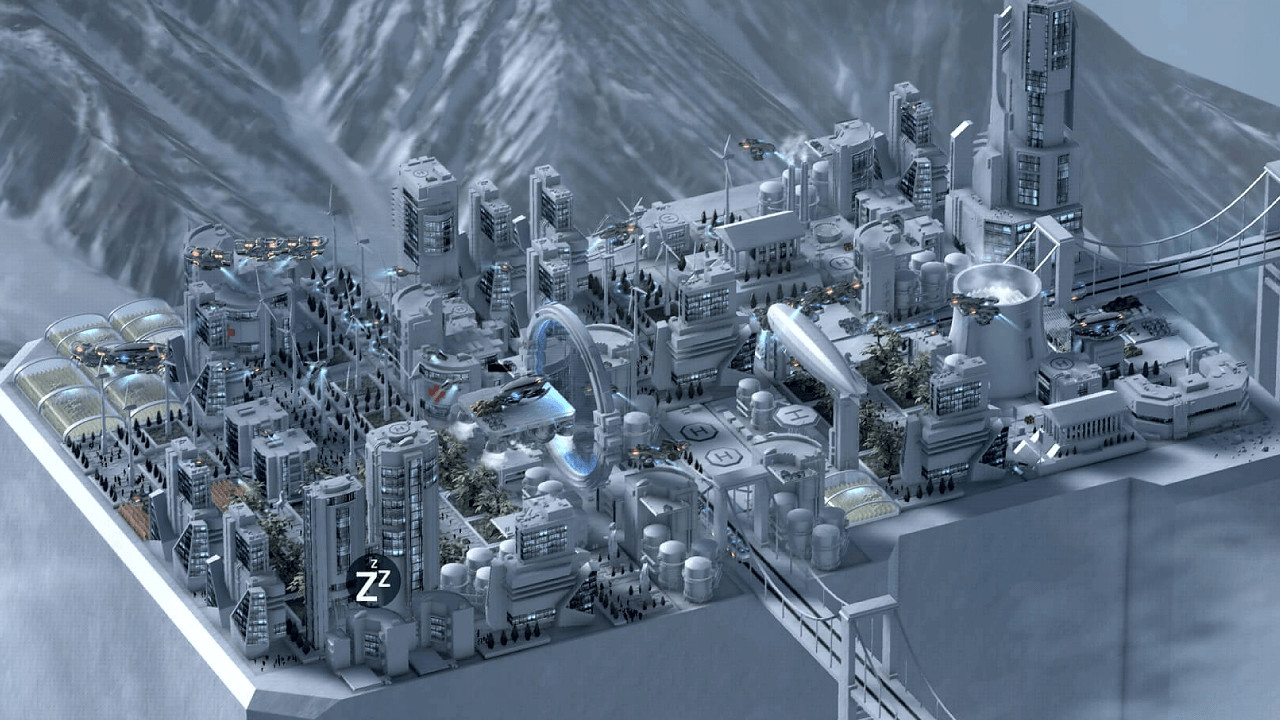In this city builder you restart civilization on a tiny plateau above a radioactive Earth
Cliff Empire stands out in a year full of city builders thanks to an evocative setting and surprising progression.

With so many city building games out this year, a new one has to offer something unique, interesting, and clever to stand out—and Cliff Empire from Lion’s Shade does just that. I was continually surprised by how well-developed and intelligent its core concepts are, especially for an Early Access joint. You have to manage three tiny cities, each trading with the others using limited goods and currency, on platforms that tower far above the surface of a ruined Earth. It doesn't hurt that the setting is extremely cool.
You are in charge of the effort to reclaim our world, building a series of cities in these stark, cold mountains.
Cliff Empire’s concept is top-notch, big idea sci-fi. A far future Earth is rendered uninhabitable by nuclear wars and catastrophe. Bands of a few thousand survivors make it to self-sustaining orbital colonies, but many have to freeze themselves due to limited resources. Others stay behind, sacrificing their lives to build massive platforms high in the mountains. When the fallout settles, these islands above the nuclear fog will be the only habitable places left on the planet. You are in charge of the effort to reclaim our world, building a series of cities in these stark, cold mountains. It is not a simple challenge. Space is limited, the Earth’s ecology is devastated, and extreme weather wracks the planet. Other bands of survivors have turned to raiding and pillaging for survival.
I was compelled by problems of strategy, making decisions between more food storage, in case a hot season caused crop failures, or more housing and businesses to increase my overall income and labor pool. As I built a precipitous plateau society I found myself asking questions like “Why can’t I hang buildings off the side?” Cliff Empire provided a story that answered my questions about its setting, and then went much further than I expected. (It also let me hang buildings off the side.)
Everything revolves around your limited space. The cliffs might seem large at first, but as your population climbs into the hundreds, then thousands, space becomes premium. One city of survivors can be mostly self-sufficient, but not if it wants to expand its population or ensure a high standard of living. A single plateau is also remarkably fragile: A bad earthquake sent one of my plateaus spiraling out of control when the food stockpile collapsed. Another city had a surplus of grain, however, so a quick trade deal kept the wolves from the door.
The best problems, the really fun problems, come as you unlock new buildings or improved infrastructure. How do you rework what you have, strategically demolishing and rebuilding, without causing an economic collapse? I had a sprawling market that made a lot of money, but it employed comparatively few people. It just wasn’t dense enough for its size. So I demolished it for housing and a recycling plant. But that market income turned out to be vital, and the influx of new people didn’t have enough jobs—so they went on social programs, costing me far more money and pushing my income into the red.
Each plateau city has its own strengths and weaknesses. One might get a lot of sun, another high winds, the third more fertile in soil or rich in minerals. These cities use money to trade with each other and with the people in orbit, and can eventually be connected by bridges and commuter trains. Balancing how the cities trade with each other is a key part of the strategy. Mine ended up revolving around a central city with businesses, commerce, towering housing, and government services. It produced a lot of raw monetary income, and it used that to act as a hub for goods from the other cities, specialized in agriculture and industry respectively.

At the same time, running up a huge trade deficit can be bad when you overproduce goods and drive the costs down. Perhaps most interesting, you can have cities loan money to each other, but the interest payments can be destructive in an economy with very tight marginal income.
Keep up to date with the most important stories and the best deals, as picked by the PC Gamer team.
Cities need resources produced by buildings at a fixed rate. Some are vital, like wheat and water. Others provide vitamins for citizen health and improve efficiency, like greens or fish. Others, VR headsets and washing machines, are completely optional—but they improve quality of life and attract settlers from orbit. A city has to be at least partly self-sufficient, because all trade has a limited volume, but no city can do everything—and there are repercussions if you try. Too much industry on one plateau means dire environmental consequences for worker health.
This all may sound pretty standard for a city builder, outside the setting, but Cliff Empire has a narrative all its own to follow. It’s not one with individual characters and a society to get to know like Frostpunk, but a much more structural one about how the conditions on this new Earth shape technological development. Those developments are twists that throw your playstyle for a loop every few hours. New buildings, increases in efficiency, new models of drones, and modular constructions change how you manage and use space on the plateaus.
You start looking at the side walls as valuable real estate, hanging buildings off the edge over the abyss. You eyeball the earth below as a route of expansion, though you know it’ll be expensive in both resources and time. Those are only the first few of the changes and new challenges that come at you—no spoilers here, but others are far more surprising and went places I didn’t expect.

Cliff Empire is in Early Access, and it shows. There are badly worded sentences and lots of imperfect English. There are frustrating interface hiccups and very, very poorly considered menu layouts. There are mechanics that aren’t explained, taking vicious trial and error to understand. At the moment, certain milestones take far longer than they should because the rates of production just haven’t been perfectly tuned. I spent about 40 hours with Cliff Empire and I definitely set the speed to the highest setting and walked away to make a sandwich at least twice.
However, I had more fun with Cliff Empire than I did with several other much-hyped city builders this year. It’s compelling to manage your expansion in a world threatened by external forces of climate and disaster. Always trying to figure out the next step to fit just a few hundred more people in a tiny space. Always hoping that the next narrative twist isn't a disaster, but a boon. That’s the core of why I like Cliff Empire so much. It’s carefully balancing these mathematics that really drives home how fun this mix of building and surviving really is. I can’t wait to see what it’s like when it’s done. It's currently $8.99/£6.99 on Steam.
Jon Bolding is a games writer and critic with an extensive background in strategy games. When he's not on his PC, he can be found playing every tabletop game under the sun.

